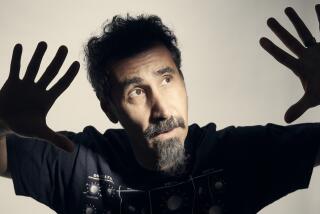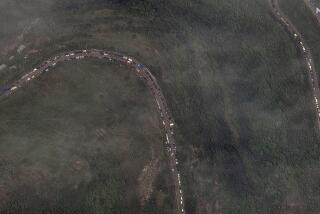Gorbachev Retires the Soviet Model for Progress
- Share via
MOSCOW — After Mikhail S. Gorbachev’s United Nations speech on Dec. 7, the world press focused its attention first of all on his chief practical proposals and the unilateral reduction of Soviet armed forces by 500,000 troops. General attention was also attracted by Gorbachev’s proposals for resolving regional conflicts and, in particular, his recent proposals on Afghanistan.
It would be a mistake, however, to reduce the entire significance of Gorbachev’s speech to just these proposals, though they will tangibly influence the world situation, especially in Europe, and help achieve positive results at the arms-reduction talks. In the U.N. speech, Gorbachev stated in terse but persuasive terms the readiness of the Soviet Union to conduct its policies on a new philosophical and political basis.
All Soviet leaders in the past started from the formula that “peaceful coexistence is just another form of ideological or class struggle”--in other words, the battle for socialism. The Soviet model for progress was supposed to be the most effective one, even though that smug statement was at odds with the real state of affairs in a multifaceted world.
For the first time, a Soviet leader had appealed to all countries, parties and movements for ideological and political tolerance, not to perceive different thinking or ideology as necessarily hostile, not to impose one’s own notions of democracy and values on others and to cooperate in solving ever more difficult economic, ecological, national and political problems of the world.
And for the first time, a Soviet leader has moved to the forefront of mankind’s common interests and values and called for unification of the world on the foundation of diversity, instead of a single ideology. In his own words, “the further progress of the world is only possible today in the form of search for the global consensus in moving toward a new world order.” Not a victory for one or another idea or system, but looking for ways to preserve vitality of our civilization, “perhaps the only one in the universe.”
This is not romantic rhetoric. Gorbachev’s comments represent an important step for the Soviet Union, setting forth a new philosophy and ideology. Of course, these remain socialist in nature, but they differ significantly from the usual Marxism-Leninism.
Having so forcefully stressed the priority of all mankind’s values and interests, Gorbachev also had to stress the tremendous importance of such universal organizations as the United Nations and to call for their greater role in world affairs. This is why he urged continuation of the Helsinki process and its extension to include such large countries as China, India, Japan and Brazil.
A few hours after Gorbachev’s speech, the attention of the mass media and of the entire world shifted from New York to the stricken cities and towns of Armenia. The earth shook before Gorbachev mounted his podium in New York, but no one then knew the true magnitude of the disaster.
Our country had to live through earthquakes of comparable magnitude twice before: in 1948 in Ashkhabad, the capital of Turkmenia in Soviet Central Asia, and in 1966 in Tashkent, the capital of Uzbekistan, also in Central Asia.
Only a brief communique appeared after the Ashkhabad quake. Even the Soviet people had no idea of the magnitude of the disaster or of the number of deaths. All work to repair the damage was done under a tight veil of secrecy; the devastated areas were cordoned off by troops.
Tashkent, razed by the quake, was rebuilt by the entire country, but the number of dead again was not disclosed, and the government decided it would not accept help from foreign sources.
This predilection for concealing the true size of a tragedy from the outside world manifested itself again as recently as 1986 after the Chernobyl disaster, where even Soviet reporters were not allowed in the first weeks. Not much time has passed, but the scope of the changes today is impressive. Not only troops, but also correspondents from all main Soviet publications came to Armenia, joined by their colleagues from the Western press.
The Soviet Union did not appeal for help but gratefully accepted all contributions, which arrived from more than 70 countries, along with thousands of rescuers. Their efforts helped to save thousands of human lives.
While the tragedy united our people, it also highlighted what I can only call criminal irresponsibility.
Even though Armenia is regarded as a seismically dangerous area, it had practically no monitoring equipment to predict big earthquakes. In Leninakan, there were houses of nine, 12 and even 16 floors, with designs not accounting for possible earth movement. Many concrete slabs proved faulty, because during their manufacture cement was used “sparingly”--stolen, in plain words. Practically all buildings erected in the last 20 years fell; only a few, dating back to Nikita Khrushchev’s time in the 1950s and early 1960s, are still standing. All these circumstances will have to be looked into, with full participation of police investigators.
Armenia is a republic with predominantly chemical industries. The public and ecological groups had long been clamoring for removal of many environmentally dangerous factories from this small mountainous land. Luckily, the biggest ones were not located near the earthquake epicenter and their depots of dangerous chemicals were not affected. Of the significant industrial enterprises, only a textile factory, electronics facility and a bicycle plant were destroyed.
As soon as the first tremor hit, people immediately thought of the Armenian nuclear power station. The station had already experienced a few minor accidents, which were prevented from becoming major catastrophes only by sheer chance. That was why the Armenian public was persistently demanding the station’s closure and the removal of all its fuel. The station’s designers and the previous leaders of the republic kept telling the people that the plant was operating safely, that it would survive large quakes. Despite the fact that in the station’s immediate locality the tremors were much weaker than those which levelled the town of Spitak, it was decided to dismantle the station over the next three years.
This is not the first decision of this kind. As is known, addition of new units at the Lithuanian nuclear facility had been halted and construction of similar stations in the Crimea and Kuban has now been stopped completely. The fate of several more nuclear power stations elsewhere is under discussion.
The region of the disaster has been the scene of sharp ethnic conflicts for more than a year now. Thousands and tens of thousands of Armenians had fled to their republic from Azerbaijan, just as their Azerbaijani counterparts were fleeing from Armenia. Unfortunately, the earthquake failed to quell ethnic passions, and in some respects the situation has worsened. Extremist-minded groups in Azerbaijan are frankly expressing their joy over the Armenian tragedy, seeing in it “the hand of Allah.”
In Kirovabad, where the army recently prevented an attack on the city’s Armenian district--three soldiers were killed and 10 wounded in the clash--a large group of youths, learning of the earthquake devastation, rushed into the city’s square, dancing and singing. Only shots in the air succeeded in dispersing the jubilant crowd. “Congratulatory” cables were sent to Armenia from various cities in Azerbaijan. Our press is now demanding that the authors of these cables be found and punished, along with those who accepted them and sent them to their destinations at the republic’s post offices.
Meanwhile, in the aftermath of the disaster, women and children who lost their homes are being moved to stay with families in Armenia, the Crimea, Krasnodar and Stavropol regions. Their men have stayed on to work in the earthquake area. The only place where they were not allowed to go was to the Armenian enclave of Nagorno-Karabakh, located in Azerbaijan. In retaliation, the Armenians blocked the roads to the Nakhichevan district, an Azerbaijani enclave in southern Armenia. Curfew and state-of-siege restrictions have been lowered in Armenia and intensified in Azerbaijan. The most radical activists in both Armenian and Azerbaijani national committees have been arrested.
In the face of such dramatic events in Armenia, few were monitoring other developments of Soviet domestic politics. The party’s own internal reelection campaign is winding up, while a new one, for elections to the People’s Congress, gathers speed. The People’s Congress, part of constitutional changes enacted in November, will be a new seat of power, convening once a year and choosing the de facto president of the country and the Supreme Soviet, which will be in session most of they year.
Transfers are meanwhile occurring at the highest level of the military hierarchy. The former chief of the general staff, Marshal Sergei Akhromeyev, has been retired, and it is expected that Gen. Dmitri T. Yazov, the defense minister, will soon be appointed the commander of the Warsaw Pact armed forces and a civilian will take his job as defense minister. In the economic sphere, the minister of finance announced that the country’s revenues were 35 billion rubles less than expenditures in 1988, a budget deficit equivalent to 8% of national revenues for the year.
The country still lives on a speeded-up political schedule, but changes in the national economy are not happening as fast as Gorbachev’s rejuvenated team would like. It is a safe guess that 1989 will prove a difficult time for all.
More to Read
Sign up for Essential California
The most important California stories and recommendations in your inbox every morning.
You may occasionally receive promotional content from the Los Angeles Times.













